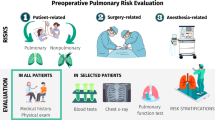Abstract
A survey of our pulmonary service revealed little consensus as to the definition, work-up, and management of hypoventilation, more often encountered in the presence of obesity. If hypoventilation is defined by an arterial carbon dioxide level above 45mmHg, 22% of artrial blood gas samples over a 5-month period met this criterium, suggesting a high “any-cause” prevalence. This article presents the rationale and explanation for a management protocol for obesity-hypoventilation that is currently being assessed in the VA Medical Center and Case Western Reserve University training program in Pulmonary and Critical Care Medicine.
Similar content being viewed by others
References
Update: prevalence of overweight among children, adolescents, and adults–-United States, 1988– 1994. MMWR 1997;46: 198–202
Executive summary of the clinical guidelines on the identification, evaluation, and treatment of overweight and obesity in adults. Arch Intern Med 1998;158:1855–1867
Burwell CS, Robin ED, Whaley RD, et al. Extreme obesity associated with alveolar hypoventilation. A Pickwickian syndrome. Am J Med 1956;21:811–816
Sugerman HJ, Baron PL, Fairman RP. Hemodynamic dysfunction in OHS and the effects of treatment with surgically induced weight loss. Ann Surg 1998;207:604–613
Zwillich CW, Sutton FD, Pierson DJ, et al. Decreased hypoxic ventilatory drive in the OHS. Am J Med 1975;59:343–348
Lopata M, Freilich RA, Onal E. Ventilatory control and the obesity hypoventilation syndrome. Am Rev Respi Dis 1979;119:165–168
Rochester DF, Enson Y. Current concepts in the pathogenesis of OHS. Mecahnical and circulatory factors. Am J Med 1974;57:402–420
Gastaut H, Tassinari CA, Duron B. Polygraphic study of the episodic diurnal and nocturnal manifestations of the Pickwick syndrome. Brain Res 1966;2:167–186
Naimark A, Cherniack RM. Compliance of the respiratory system in health and obesity. J Appl Physiol. 1960;15:377–382
Lopata M, Evanich MJ, Lourenco RV. Quantification of diaphragmatic EMG response to CO2 rebreathing in humans. J Appl Physiol 1977;43:262–270
Sharp JT,.Druz W, Kondragunta V. Diaphragmatic responses to body position changes in obese patients with OSA. Am Rev Respir Dis 1986;133:32–37
Bedell GN, Wilson WR, Seebohm PM. Pulmonary function in obese persons. Clin Invest 1958;37:1049–1055
Holley HS, Milic-Emili J, Becklake MR, Bates DV. Regional distribution of pulmonary ventilation and perfusion in obesity. J Clin Invest 1967;46:435–441
Kuczmarski RJ, Flegal DM, Campbell SM, et al. Increasing prevalence of overweight among US adults. JAMA 1994; 272:205–211
Vgontzas AN, Bixler EO, Tan TL, et al. Obesity without sleep apnea is associated with excess daytime sleepiness. Arch Int Med 1998;158:1333–1337
Bradley TD, Rutherford R, Lue F, et al. Role of diffuse airway obstruction in the hypercapnea of OSA. Am Rev Respir Dis 1986;134:920–924
Garay SM, Rapoport D, Sorkin B, et al. Regulation of ventilation in the OSAS. Am Rev Resp Dis 1981;124:451–457
Vincken WG, Elleker MG, Cosio MG. Determinants of respiratory muscle weakness in chronic neuromuscular disorders. Am J Med 1987;82:53–58
Foreyt JP, Goodrick GK, Gotto AM. Limitations of behavioral treatment of obesity: Review and analysis. J Behave Med 1981;4:171–174
Harman EM, Wynne JW Block AJ, et al. The effect of weight loss on sleep disordered breathing and oxygen desaturation in morbidly obese men. Chest 1982;82:291–294
Sugerman HJ, Baron PL, Fairman RP. Hemodynamic dysfunction in OHS and the effects of treatment with surgically induced weight loss. Ann Surg 1988;207:604–613
Sullivan CE, Issa FG, Berthon-Jones M, et al. Reversal of OSA by CPAP applied through the nares. Lancet 1981;1:862–865
Kessler R, Chaouat A, Weitzenblum E, et al. Pulmonary hypertension in the OSA syndrome: Prevalence, causes and therapeutic consequences. Eu Resp J 1996;9;787–794
Pankow W, Hijjeh N, Schuttler F, et al. Influence of noninvasive positive pressure ventilation on inspiratory muscle activity in obese subjects. Eu Resp J 1997;10:2847–2852
Sanders MH, Gruendle CA, Rogers RM. Patient compliance with nasal CPAP therapy for sleep apnea. Chest 1986;90: 330–333
Rolfe I, Olson LG, Saunders NA. Longterm acceptance of CPAP in OSA. Am Rev Respi Dis 1991;144:1130–1133
Hoffstein V, Viner S, Mateika S. Treatment of OSA with nCPAP: Patient compliance, perception of benefit, and side effects. Am Rev Respir Dis 1992;145:841–845
White DP, Zwillich CW, Pickett CK, et al. Central sleep apnea improvement with acetazolamide therapy. Arch Int Med 1982;142:1816–1819
Tojima H, Kunitomo F, Kimura H. Effects of acetazolamide in patients with the sleepapnea syndrome. Thorax 1988;43: 113–119
Shore ET, Millman RP. Central sleep apnea and acetazolamide therapy. Arch Int Med 1983;143:1278–1280
Hudgel DW, Pharmacologic treatment of obstructive sleep apnea. J Lab Clin Med 1995;126:13–18
Strohl KP, Hensley MJ, Saunders NA. Progesterone administration and progressive sleep apneas. JAMA 1981;245: 1230–1232
Fee WE, Ward PH. Permanent tracheostomy: a new surgical technique. Ann Otol Rhinol Laryngol 1977;86:635–638
Author information
Authors and Affiliations
Corresponding author
Rights and permissions
About this article
Cite this article
Subramanian, S., Strohl, K.P. A Management Guideline for Obesity-Hypoventilation Syndromes. Sleep Breath 3, 131–138 (1999). https://doi.org/10.1007/s11325-999-0131-3
Issue Date:
DOI: https://doi.org/10.1007/s11325-999-0131-3




